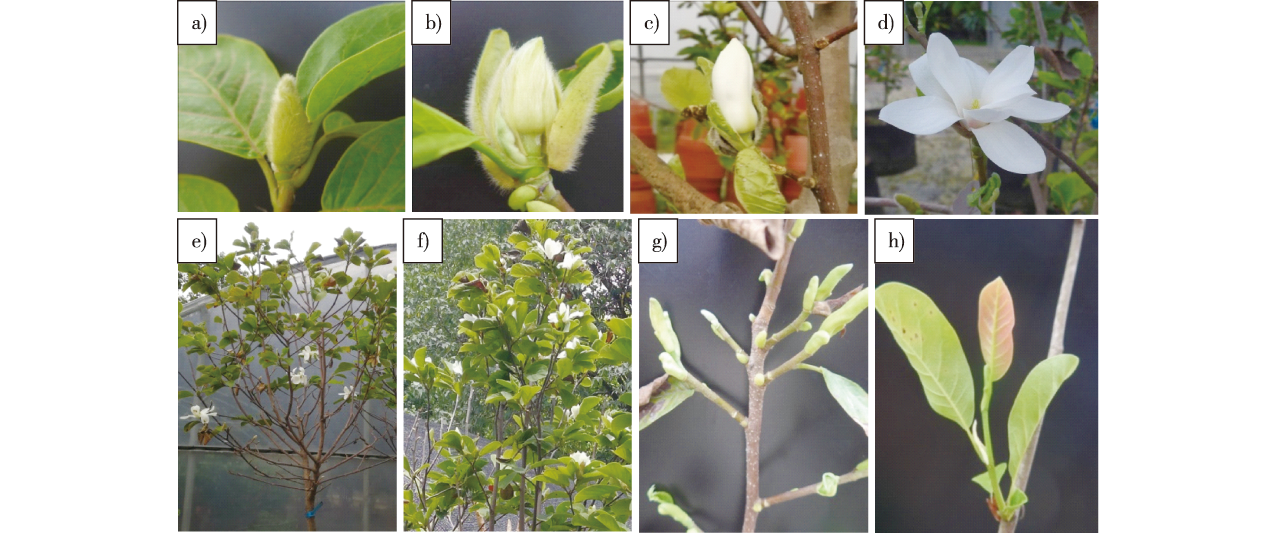 PDF(6803 KB)
PDF(6803 KB)


Induction and physiological regulatory mechanism of secondary flowering in Yulannia denudata
CHEN Xiangbo, ZHANG Dongmei, FU Renjie, ZHANG Lang, SHEN Yamei, LUO Yulan, YIN Lijuan
Journal of Nanjing Forestry University (Natural Sciences Edition) ›› 2024, Vol. 48 ›› Issue (5) : 97-104.
 PDF(6803 KB)
PDF(6803 KB)
 PDF(6803 KB)
PDF(6803 KB)
Induction and physiological regulatory mechanism of secondary flowering in Yulannia denudata
【Objective】The aim of this study was to achieve the secondary flowering of Yulannia denudata through artificial induction and to explore the physiological regulation mechanism of flower bud differentiation and flowering induction in Y. denudata.【Method】Y. denudata plants were treated with nutrients and hormones. Flower buds were embedded in paraffin and sectioned to observe flower bud development, and endogenous hormone contents in flower buds at different stages were measured.【Result】Flower bud differentiation of Y. denudata began in early May when vegetative growth slowed down and was completed by early June. Secondary flowering within the same year was induced via treatment with exogenous hormones [6-benzylaminopurine (6-BA) and gibberellin A3 (GA3)] alone or in combination with nutrient applications [nitrogen (N), phosphorus (P), potassium (K) and sugars]. The secondary flowering rate ranged from 33% to 100%, with the maximum of 22 flowers per plant. During the maturation of flower bud differentiation, the levels of endogenous GA3 and abscisic acid (ABA) increased. The ABA content in flower buds decreased while breaking dormancy and flowering, whereas the content of endogenous auxins (indole-3-acetic acid (IAA) and methylindole-3-acetic acid (ME-IAA) increased. Flower buds treated with exogenous cytokinins had higher levels of ME-IAA, IPA, jasmonoyl-l-isoleucine (JA-Ile) and jasmonate (JA), while flower buds treated with exogenous gibberellins (GA3) had higher levels of endogenous trans-zeatin riboside (tZR), gibberellin A1 (GA1), and GA3. 【Conclusion】Exogenous hormones directly induce secondary flowering in Y. denudata without relying on nutrient treatments. Thus, different hormones may induce secondary flowering through various regulatory pathways.

Yulannia denudata / differentiation of flower bud / secondary flowering / physiological regulation / nutrition / hormone
| [1] |
中国科学院中国植物志编辑委员会. 刘玉壶. 中国植物志.第30(1)卷.被子植物门.双子叶植物纲.防已科木兰科[M]. 北京: 科学出版社, 1996.
Chinese Academy of Sciences, Editorial Committee of Flora of China,
|
| [2] |
舒素芳, 毛俊萱, 蔡敏. 白玉兰始花期与气象因子的关系分析[J]. 浙江农业学报, 2013, 25(2):248-251.
|
| [3] |
范李节, 陈梦倩, 王宁杭, 等. 3种木兰属植物花芽分化时期及形态变化[J]. 东北林业大学学报, 2018, 46(1):27-30,39.
|
| [4] |
武祖发, 胡建军, 斯华文, 等. 玉兰花芽分化观察[J]. 中国中药杂志, 1991, 16(2):79-81,126.
|
| [5] |
张杰, 张春英, 王亚玲, 等. 木兰珍品:多季开花木兰[J]. 园林, 2018, 11:56-59.
|
| [6] |
蒋政, 孙李勇, 刘旭, 等. 常春二乔玉兰春夏季开花节律及营养效应研究[J]. 植物研究, 2019, 39(2):192-199.
|
| [7] |
唐启义, 冯明光. 统计分析及数据挖掘[M]. 北京: 科学出版社, 2007.
|
| [8] |
陈建业, 鲁国荣, 宁玉霞, 等. 木兰属等3属植物的芽种类、结构与成枝规律研究[J]. 中国农学通报, 2012, 28(34):46-52.
|
| [9] |
|
| [10] |
|
| [11] |
程少禹. ‘红元宝’紫玉兰两次花芽分化糖含量变化及转录组分析[D]. 杭州: 浙江农林大学, 2021.
|
| [12] |
程少禹, 宣铃娟, 董彬, 等. ‘红元宝’紫玉兰两次花芽分化差异代谢通路及关键调控基因筛选[J]. 园艺学报, 2020, 47(8):1490-1504.
|
| [13] |
赵慧慧. 高温胁迫下小麦中植物激素对外源海藻糖的响应[D]. 上海: 华东师范大学, 2016.
|
| [14] |
肖爱华, 陈发菊, 贾忠奎, 等. 梯度洗脱高效液相色谱法测定红花玉兰中4种植物激素[J]. 分析试验室, 2020, 39(3):249-254.
|
| [15] |
牛辉陵, 张洪武, 边媛, 等. 枣花分化发育过程及其内源激素动态研究[J]. 园艺学报, 2015, 42(4):655-664.
|
| [16] |
孙斌. 盆栽金银花花期调控初步研究[J]. 山东林业科技, 2015, 45(6):41-43.
|
| [17] |
温璐华, 王真, 庄维兵, 等. 外源GA4处理解除果梅花芽休眠的生理效应研究[J]. 中国南方果树, 2015, 44(5):16-22.
|
| [18] |
|
| [19] |
潘瑞炽, 董愚得. 植物生理学[M]. 北京: 高等教育出版社, 1998.
|
| [20] |
|
| [21] |
肖安琪. 三角梅花芽分化的内源激素变化与花期调控研究[D]. 广州: 华南农业大学, 2016.
|
| [22] |
|
| [23] |
|
| [24] |
|
| [25] |
孙丽, 徐启江. 高等植物开花诱导途径信号整合的分子机制[J]. 生物技术通讯, 2009, 20(6):885-890.
|
| [26] |
|
| [27] |
|
| [28] |
|
| [29] |
杨小凤, 李小蒙, 廖万金. 植物开花时间的遗传调控通路研究进展[J]. 生物多样性, 2021, 29(6):825-842.
|
/
| 〈 |
|
〉 |